Rainfall Pattern Construction Method Based on DTW-HCA and Urban Flood Simulation: A Case Study of Nanchang City, China
Abstract
:1. Introduction
2. Materials and Methods
2.1. Study Area and Data Sources
2.1.1. Study Area
2.1.2. Data Sources
2.2. Methods of Rainfall Clustering and Characteristic Extraction
2.2.1. Clustering Method of Rainfall Events
2.2.2. Characteristic Extraction Method of Rainfall Time Series
2.3. Method of Constructing a Designed Rainfall Pattern and Rainfall Pattern for Verification
2.3.1. Construction of a Flood Model
2.3.2. Methods of Constructing a Designed Rainfall Pattern
2.3.3. Method of Constructing Rainfall Patterns for Verification
- (1)
- Method of Constructing an ERPUDFV
- (2)
- Method of Constructing an ERPWCFV
3. Results and Discussion
3.1. Results of Rainfall Clustering and Characteristic Extraction
3.1.1. Results of Rainfall Clustering
3.1.2. Results of Characteristic Extraction
3.2. Flood Simulation and Construction of Rainfall Patterns
3.2.1. Analysis of the Simulation Results and Construction of a Designed Rainfall Pattern
3.2.2. Analysis of the Simulation Results and Construction of a Rainfall Pattern for Verification
- (1)
- The Construction of an ERPUDFV
- (2)
- The Construction of an ERPWCFV
4. Conclusions
- The DTW-HCA, K-means algorithm and hierarchical clustering algorithm were used to cluster 428 rainfall events in the urban area of Nanchang City. The results indicate that the DTW-HCA outperformed the other two algorithms in identifying temporal similarities among time series.
- A designed rainfall pattern (DRP) and two rainfall patterns for verification (ERPUDFV and ERPWCFV) are proposed by flood simulation. Among them, the DRP had the highest proportion, accounting for 73.1% of the total, which could provide a reference for the design of municipal and water conservancy facilities. The ERPUDFV caused the most serious urban waterlogging, which could provide a reference for the verification of municipal facilities. The ERPWCFV resulted in the highest water levels and discharge at monitoring points, posing significant risks to water conservancy infrastructures, which could provide a reference for the verification of water conservancy facilities.
Author Contributions
Funding
Data Availability Statement
Conflicts of Interest
References
- Mechler, R.; Singh, C.; Ebi, K.; Djalante, R.; Thomas, A.; James, R.; Tschakert, P.; Wewerinke-Singh, M.; Schinko, T.; Ley, D. Loss and Damage and limits to adaptation: Recent IPCC insights and implications for climate science and policy. Sustain. Sci. 2020, 15, 1245–1251. [Google Scholar] [CrossRef]
- Clarke, B.; Otto, F.; Stuart-Smith, R.; Harrington, L. Extreme weather impacts of climate change: An attribution perspective. Environ. Res. Clim. 2022, 1, 012001. [Google Scholar] [CrossRef]
- Frame, D.J.; Rosier, S.M.; Noy, I.; Harrington, L.J.; Carey-Smith, T.; Sparrow, S.N.; Stone, D.A.; Dean, S.M. Climate change attribution and the economic costs of extreme weather events: A study on damages from extreme rainfall and drought. Clim. Change 2020, 162, 781–797. [Google Scholar] [CrossRef]
- Liu, J.H.; Pei, Y.J.; Mei, C.; Liu, C.J. Waterlogging Cause and Disaster Prevention and Control of “7·20” Torrential Rain in Zhengzhou. J. Zhengzhou Univ. (Eng. Sci.) 2023, 44, 38–45. [Google Scholar] [CrossRef]
- LeComte, D.U.S. Weather Highlights 2022—Drought, Flash Floods, Severe Outbreaks, Hurricane Ian, Blockbuster Winter Storms. Weatherwise 2023, 76, 14–22. [Google Scholar] [CrossRef]
- Liu, J.H.; MEI, C.; Wang, J.; Wang, D.; Wang, H. Flood survey of “23 · 7” heavy rain in Mentougou Watershed of Beijing. China Flood Drought Manag. 2023, 33, 50–55. [Google Scholar] [CrossRef]
- Qiu, J.; Zhao, W.; Brocca, L.; Tarolli, P. Storm Daniel revealed the fragility of the Mediterranean region. Innov. Geosci. 2023, 1, 100036. [Google Scholar] [CrossRef]
- Zhang, H.P.; Li, M.; He, R.M.; Zang, W.B.; Liu, S.; Hu, C.H. Application Scenarios and Corresponding Technical Strategies of Urban Flood Modeling. Adv. Water Sci. 2022, 33, 452–461. [Google Scholar] [CrossRef]
- Sidek, L.M.; Jaafar, A.S.; Majid, W.H.A.W.A.; Basri, H.; Marufuzzaman, M.; Fared, M.M.; Moon, W.C. High-Resolution Hydrological-Hydraulic Modeling of Urban Floods Using InfoWorks ICM. Sustainability 2021, 13, 10259. [Google Scholar] [CrossRef]
- Bisht, D.S.; Chatterjee, C.; Kalakoti, S.; Upadhyay, P.; Sahoo, M.; Panda, A. Modeling urban floods and drainage using SWMM and MIKE URBAN: A case study. Nat. Hazards 2016, 84, 749–776. [Google Scholar] [CrossRef]
- Mustafa, A.; Szydłowski, M.; Veysipanah, M.; Hameed, H.M. GIS-based hydrodynamic modeling for urban flood mitigation in fast-growing regions: A case study of Erbil, Kurdistan Region of Iraq. Sci. Rep. 2023, 13, 8935. [Google Scholar] [CrossRef] [PubMed]
- Zhang, J.Y.; Wang, Y.T.; Liu, C.S.; He, R.M. Discussion on the standards of urban flood and waterlogging prevention in China. J. Hydroelectr. Eng. 2017, 36, 1–6. [Google Scholar]
- Liu, Z.M.; Xiong, S.M.; Lei, Y.; Hu, H.Y. Study on design standard matching between municipal drainage and water conservancy drainage in urban local flood control. Water Resour. Prot. 2022, 38, 125–132. [Google Scholar]
- Liu, Y.; Zhang, S.Y.; Liu, L.; Wang, X.W.; Huang, H.B. Research on urban flood simulation: A review from the smart city perspective. Prog. Geogr. 2015, 34, 494–504. [Google Scholar]
- Molokov, M.B.; Shigorin, G.G. Rain and Alloy Sewerage; Publishing house, Ministry of Urban Affairs of the Socialist Federal Republic: Moscow, Russia, 1954.
- Keifer, C.J.; Chu, H.H. Synthetic storm pattern for drainage design. J. Hydraul. Div. 1957, 83, 1332-1–1332-5. [Google Scholar] [CrossRef]
- Huff, F.A. Time distribution of rainfall in heavy storms. Water Resour. Res. 1967, 3, 1007–1019. [Google Scholar] [CrossRef]
- Pilgrim, D.H.; Cordery, I. Rainfall temporal patterns for design floods. J. Hydraul. Div. 1975, 101, 81–95. [Google Scholar] [CrossRef]
- Yen, B.C.; Chow, V.T. Design hyetographs for small drainage structures. J. Hydraul. Div. 1980, 106, 1055–1076. [Google Scholar] [CrossRef]
- Wang, B.Y.; Zhao, L.N.; Gong, Y.F.; Bai, X.M. Characteristics of temporal pattern and return period of short-duration rainfall at Beijing Observatory. Torrential Rain Disasters 2015, 34, 302–308. [Google Scholar]
- Xu, J.J.; Yang, Z.Y.; Gao, X.C.; Gao, K. Analysis of rainstorm pattern characteristics in typical cities in the Yangtze River Basin. J. China Inst. Water Resour. Hydropower Res. 2023, 21, 1–9+22. [Google Scholar] [CrossRef]
- Fu, X.; Kan, G.; Liu, R.; Liang, K.; He, X.; Ding, L. Research on Rain Pattern Classification Based on Machine Learning: A Case Study in Pi River Basin. Water 2023, 15, 1570. [Google Scholar] [CrossRef]
- Huang, G.R.; Chen, Y.S.; Yao, Z.J. Spatial and temporal evolution characteristics of extreme rainfall in the Pearl River Delta under high urbanization. Adv. Water Sci. 2021, 32, 161–170. [Google Scholar]
- Muda, L.; Begam, M.; Elamvazuthi, I. Voice Recognition Algorithms using Mel Frequency Cepstral Coefficient (MFCC) and Dynamic Time Warping (DTW) Techniques. J. Comput. 2010, 2, 138–143. [Google Scholar] [CrossRef]
- Lichtenauer, J.F.; Hendriks, E.A.; Reinders, M.J.T. Sign Language Recognition by Combining Statistical DTW and Independent Classification. IEEE Trans. Pattern Anal. Mach. Intell. 2008, 30, 2040–2046. [Google Scholar] [CrossRef] [PubMed]
- Rybarczyk, Y.; Deters, J.K.; Gonzalo, A.A.; Esparza, D.; Gonzalez, M.; Villarreal, S.; Nunes, I.L. Recognition of Physiotherapeutic Exercises through DTW and Low-Cost Vision-Based Motion Capture. In Advances in Human Factors and Systems Interaction; Springer International Publishing: Cham, Switzerland, 2018; pp. 348–360. [Google Scholar]
- Ni, Z.N.; Li, Q.F.; Du, F.R.; Jiang, H.T. Study on design of rainstorm pattern based on short duration in Nanjing City. J. Water Resour. Water Eng. 2019, 30, 57–62. [Google Scholar]
- Li, P.L.; Qin, G.H.; Cao, L.R.; Tong, X.; Wang, J.H. Application of MIKE URBAN-based urban waterlogging model. Water Resour. Hydropower Eng. 2018, 49, 11–16. [Google Scholar] [CrossRef]
- Tang, M.; Xu, W.B. Research on the Joint Scheduling Strategy of the Urban Drainage System Based on Scenario Simulation. China Rural. Water Hydropower 2020, 8, 76–81. [Google Scholar]
- Jiang, M. Study of Shanghai Design Rainstorm Profile Under the New Rainstorm Situation. J. Hunan Inst. Sci. Technol. (Nat. Sci.) 2015, 28, 69–73+80. [Google Scholar]
- Sarkar, S.K.; Rahman, M.A.; Esraz-Ul-Zannat, M.; Islam, M.F. Simulation-based modeling of urban waterlogging in Khulna City. J. Water Clim. Change 2021, 12, 566–579. [Google Scholar] [CrossRef]
- Yan, W.C.; Liu, J.H.; Mei, C.; Feng, J.; Yang, Z.Y.; Fu, X.R.; Zhang, D.J. Simulation and analysis of flood process under typical typhoon rainstorm scenarios. Water Resour. Hydropower Eng. 2021, 52, 12–23. [Google Scholar] [CrossRef]
- Zhang, G. Study on Design Rainstorm Pattern of Recurrence Interval for Urban Flooding Design. Sci. Technol. Innov. 2023, 19, 129–132. [Google Scholar]
- Li, X.N.; Yu, Y.; Wang, C.H.; Zheng, S.W.; Li, L.J.; Chen, G. Monitoring and characterization of the entire urban flooding process in the typical southern plain river network area. J. Hydraul. Eng. 2022, 53, 845–853. [Google Scholar] [CrossRef]
- Tang, M.; Xu, W.B.; Yao, J.H.; Tang, C.S. Design Rainstorm Patterns Based on Numerical Simulation of Urban Flooding. China Water Wastewater 2021, 37, 97–105. [Google Scholar] [CrossRef]
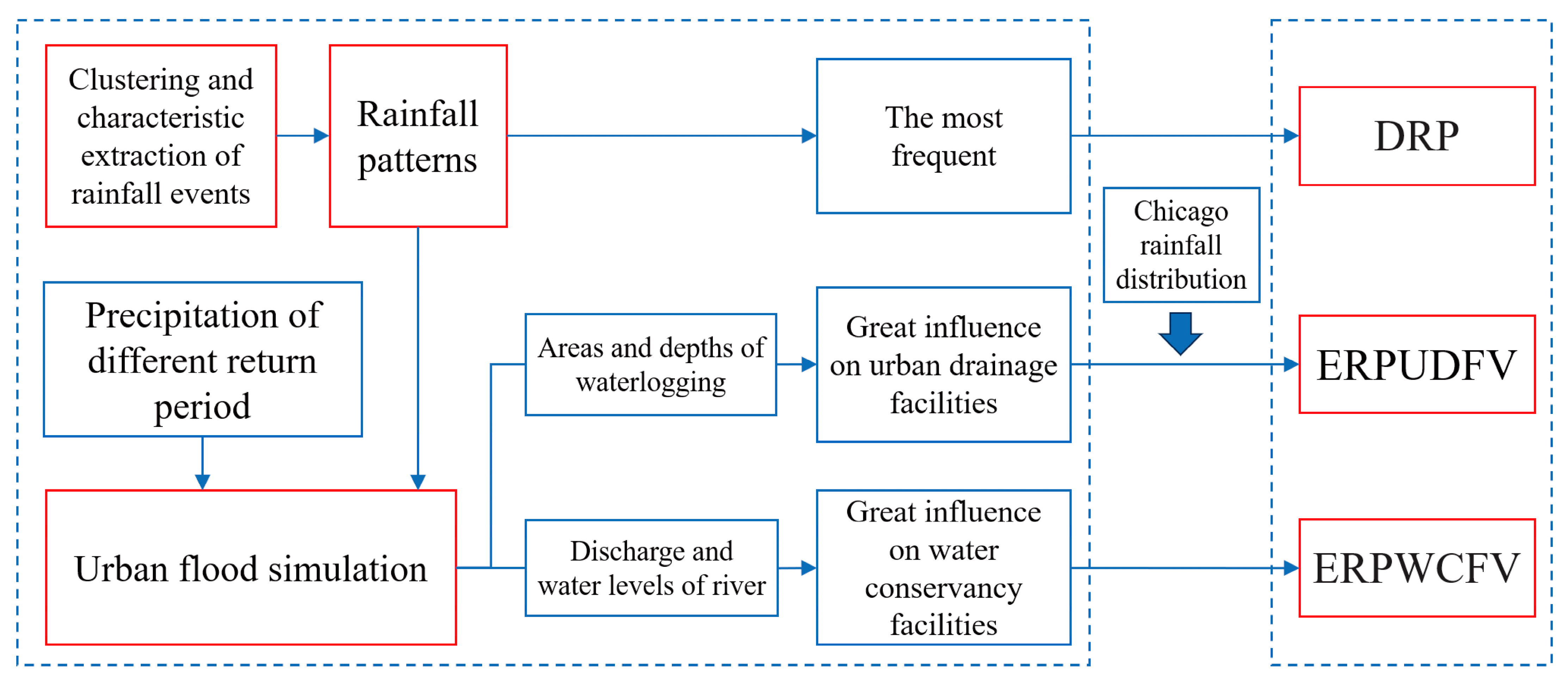
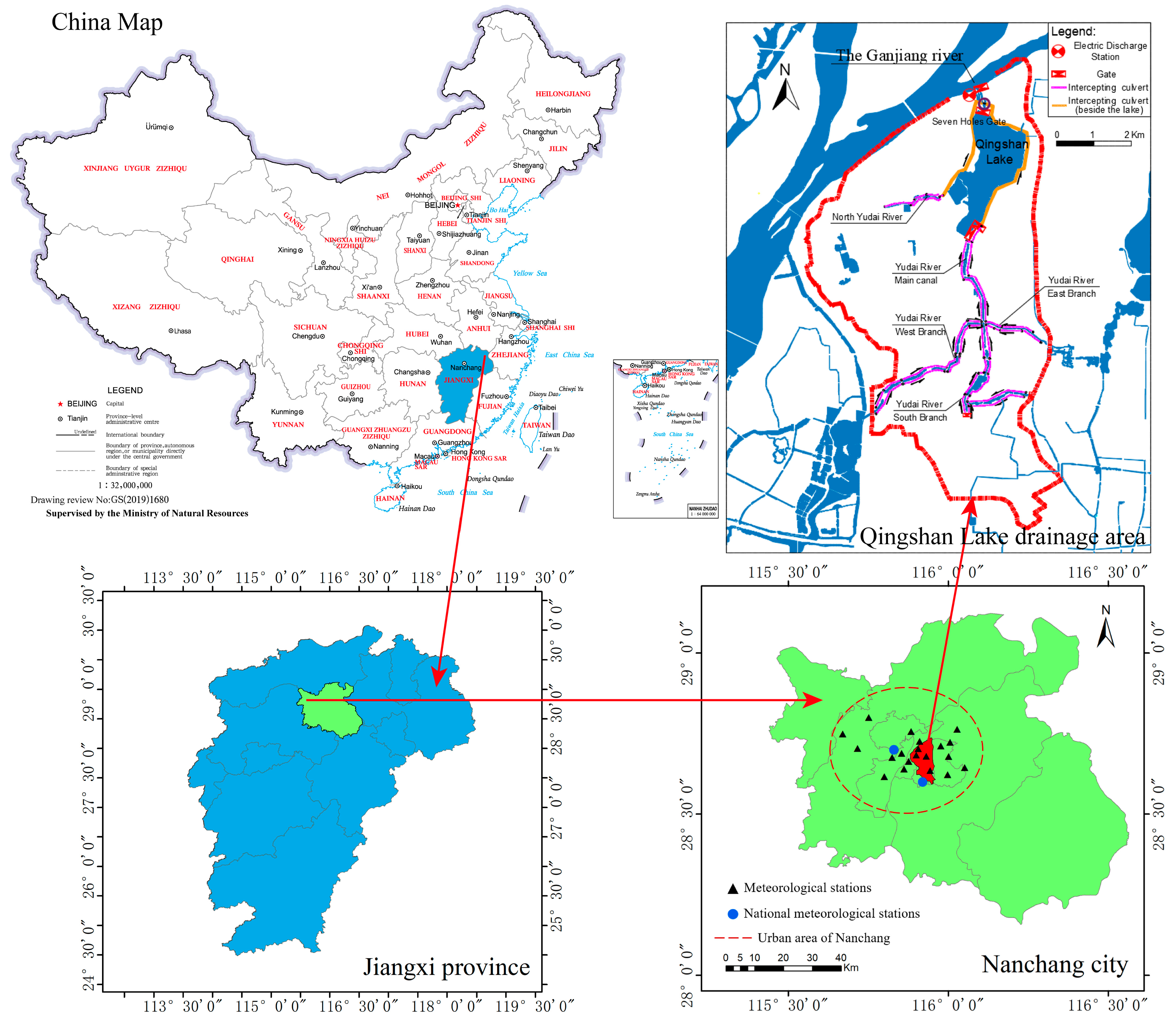
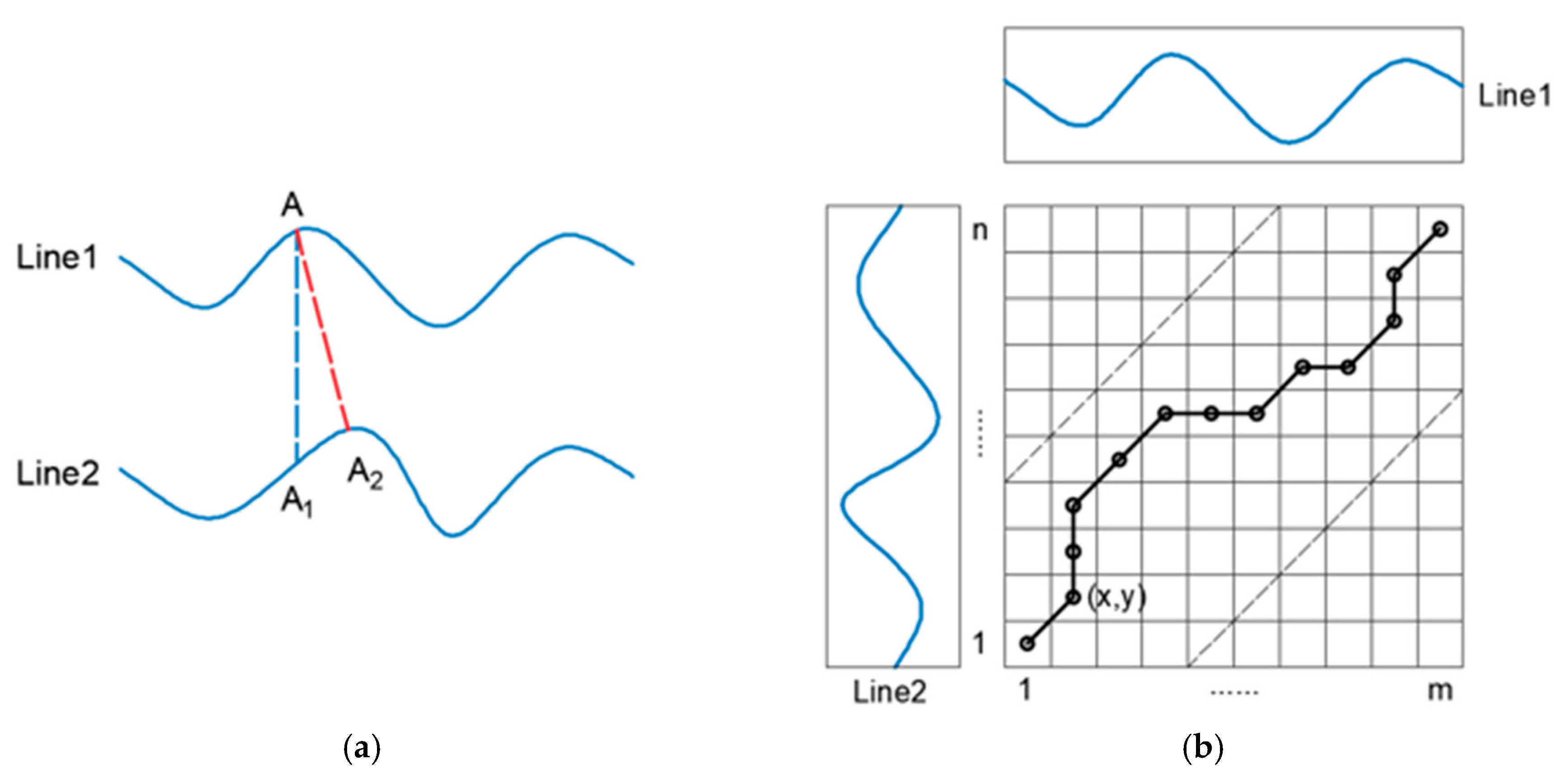

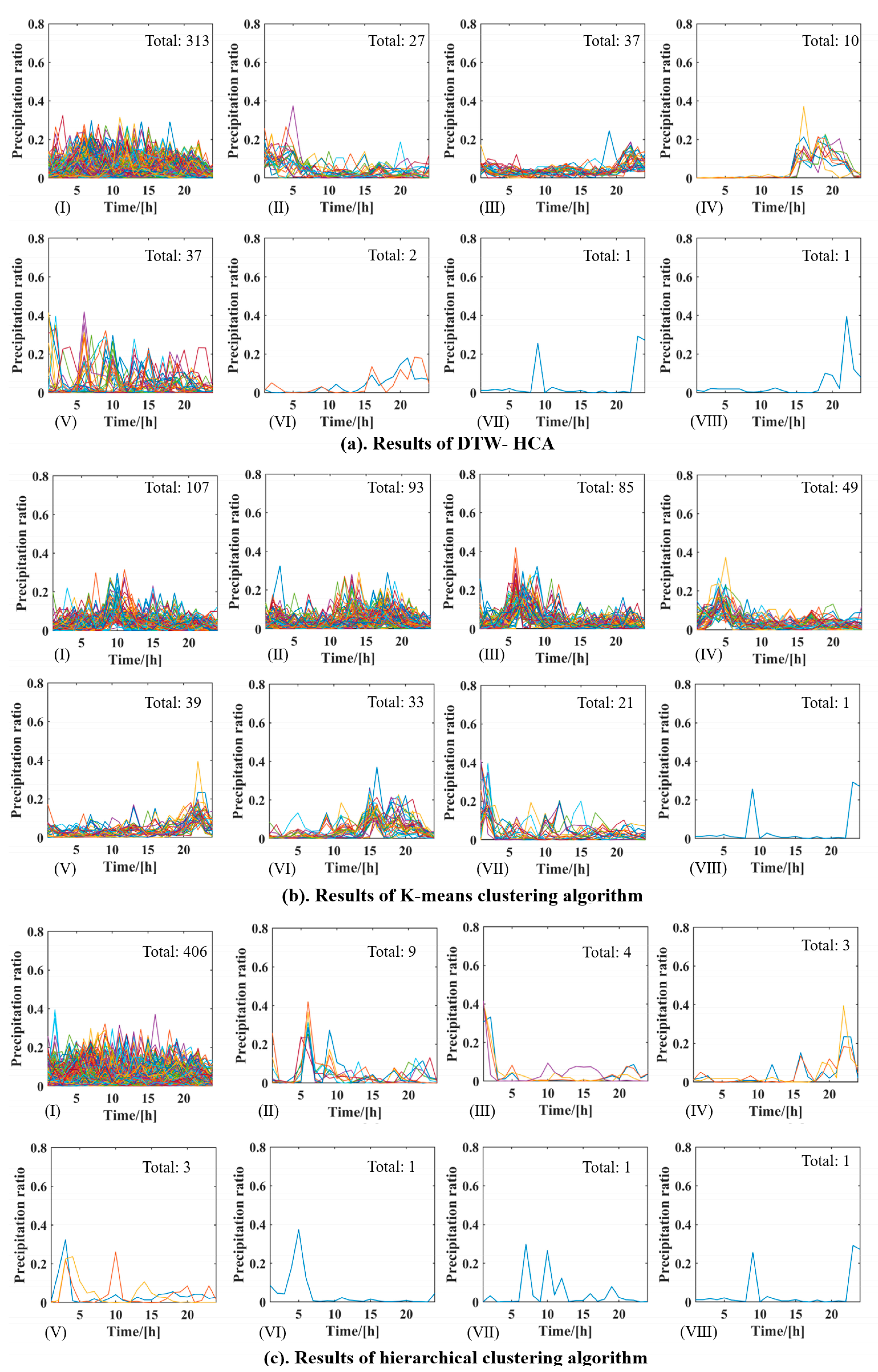
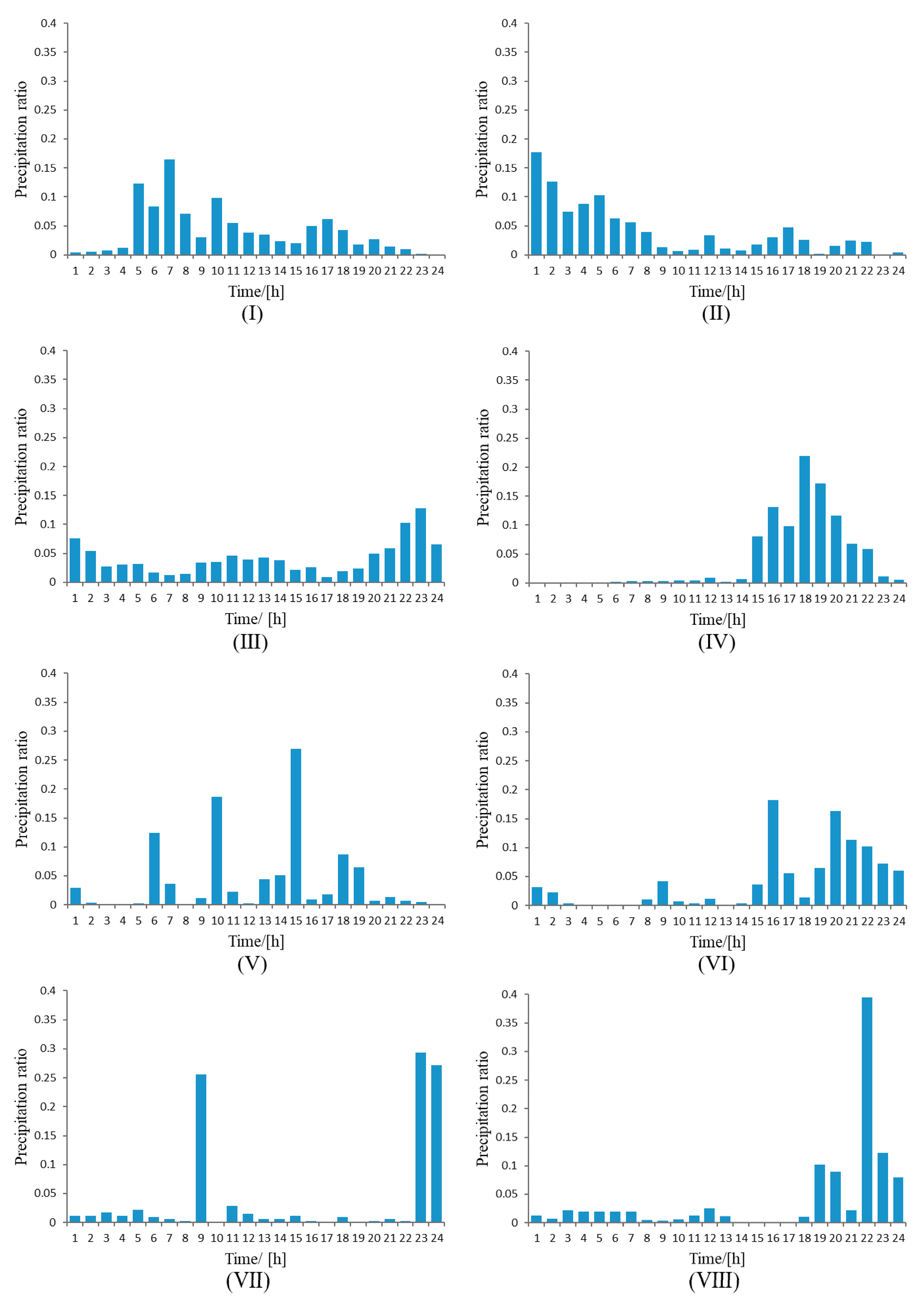

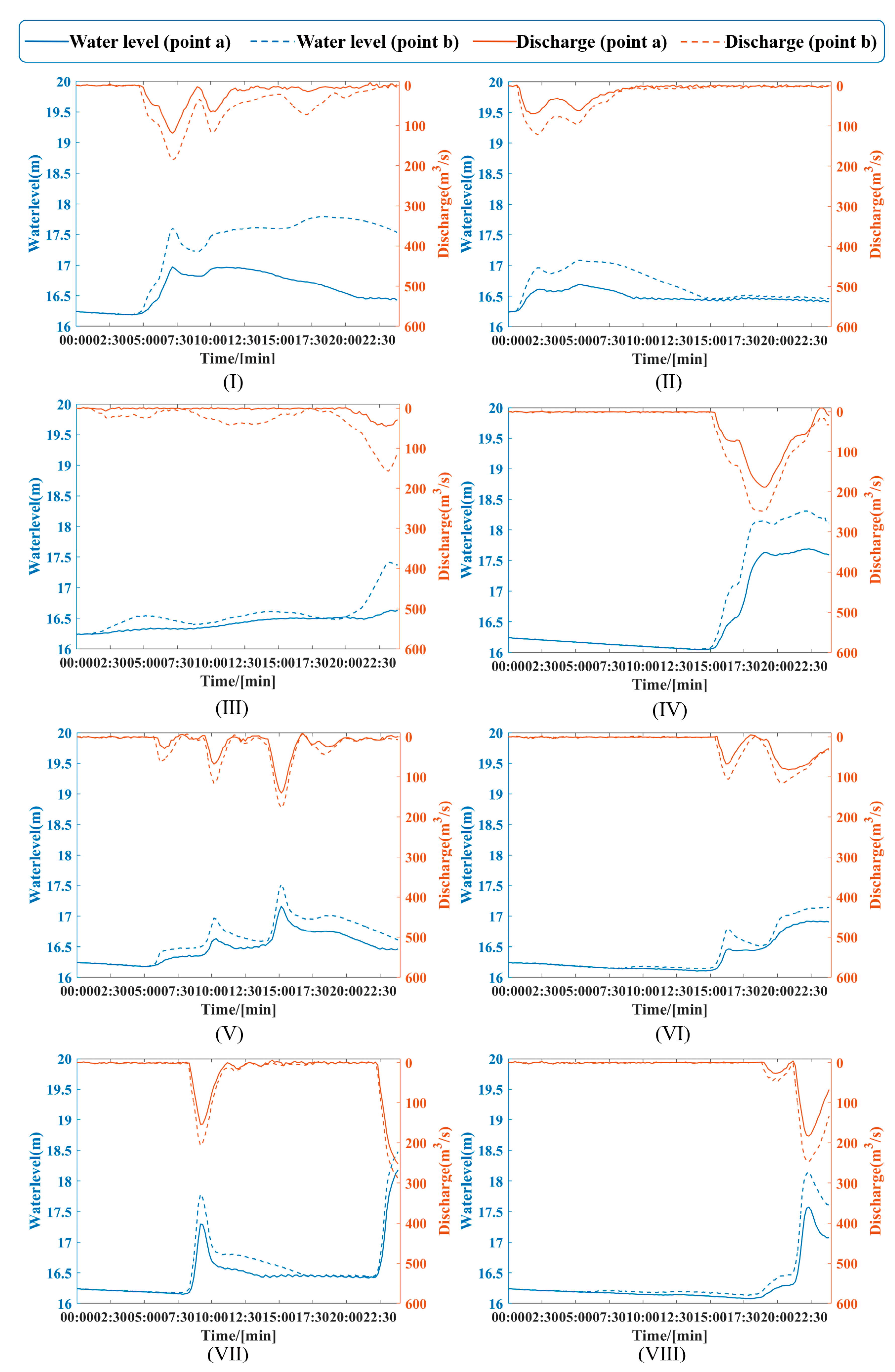
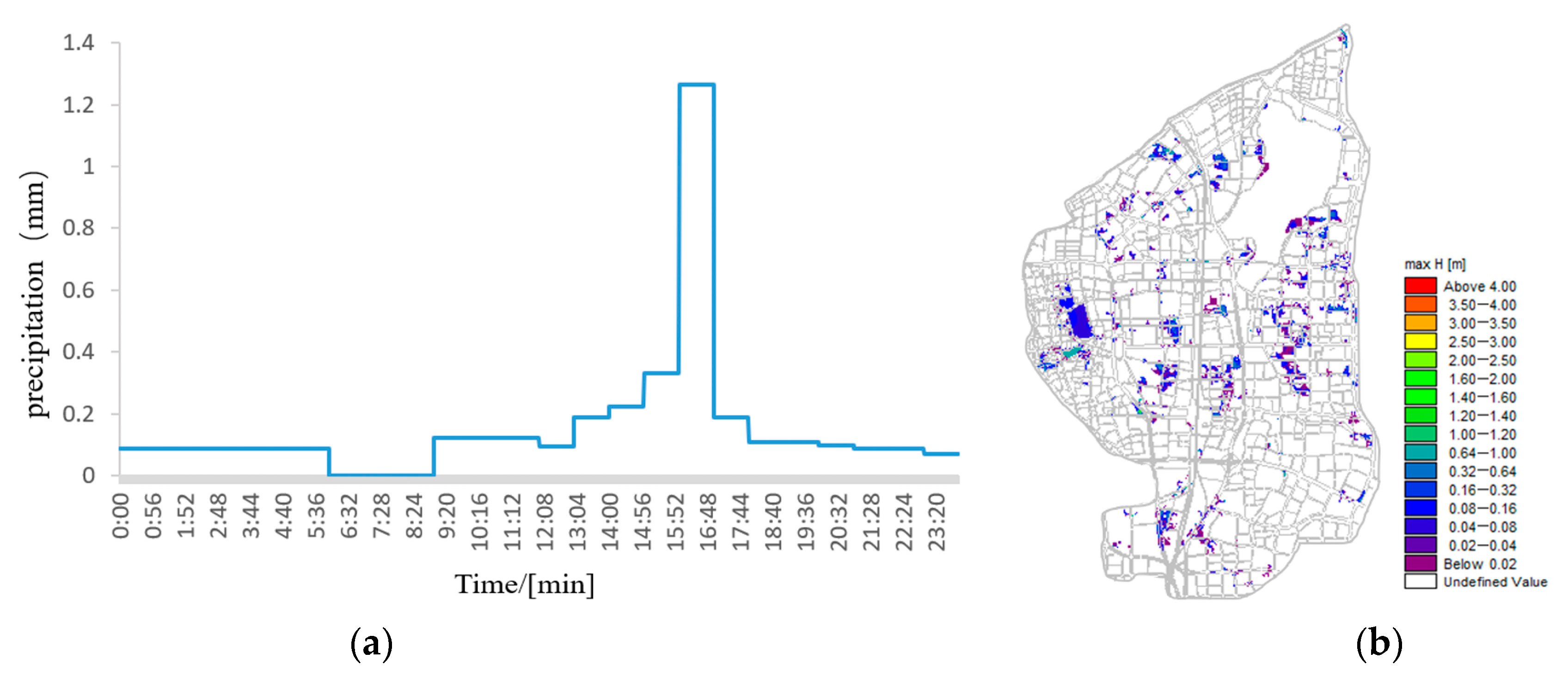
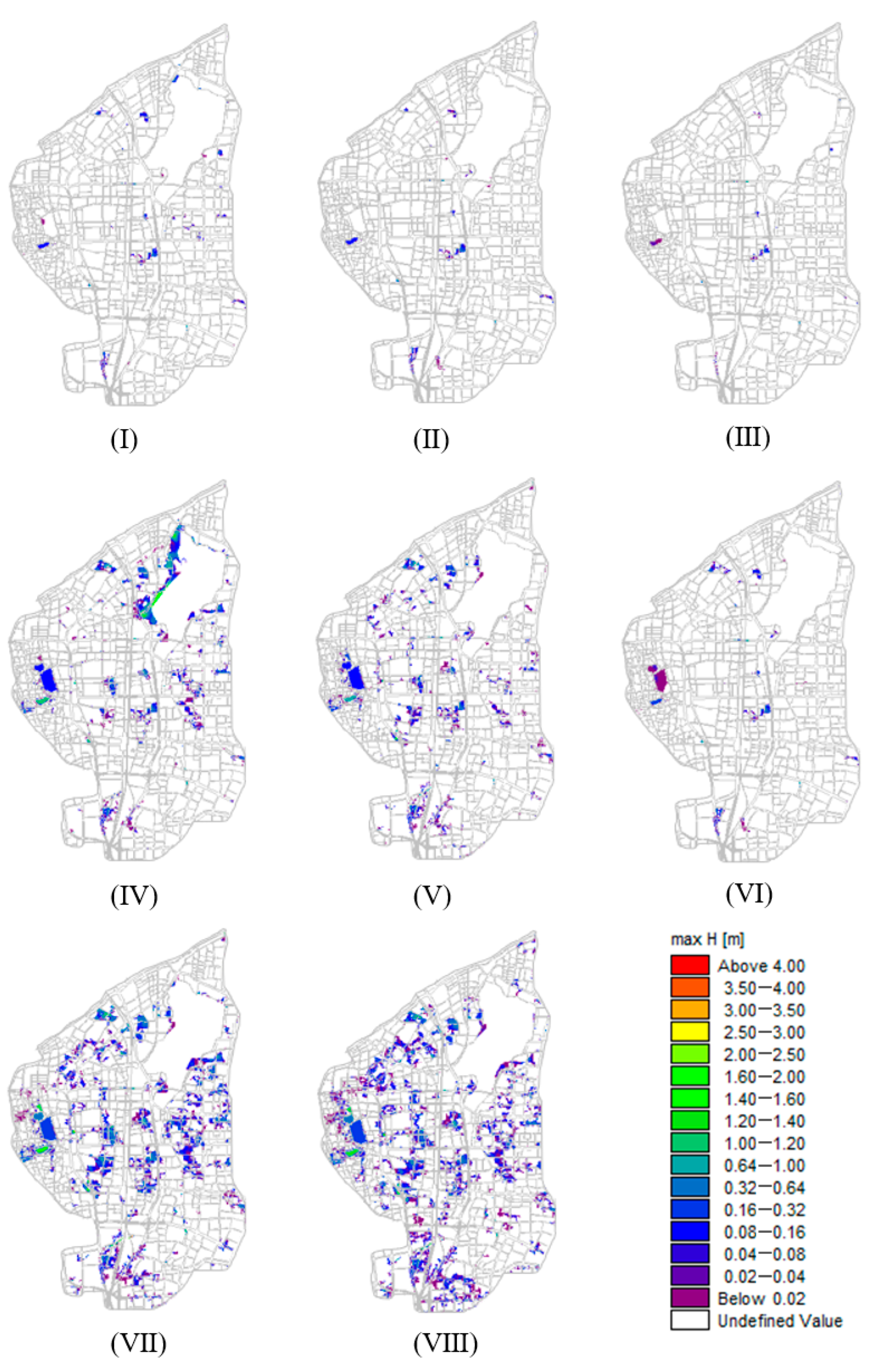
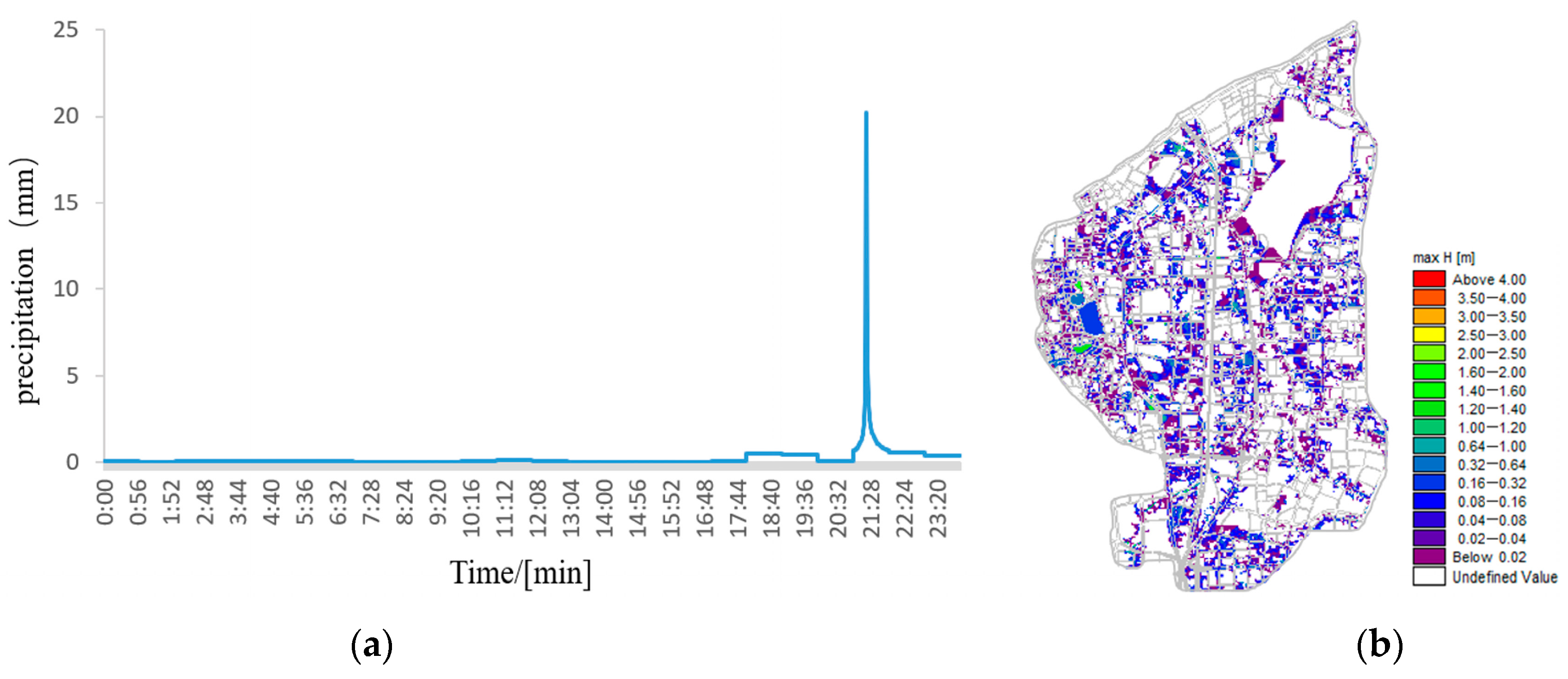
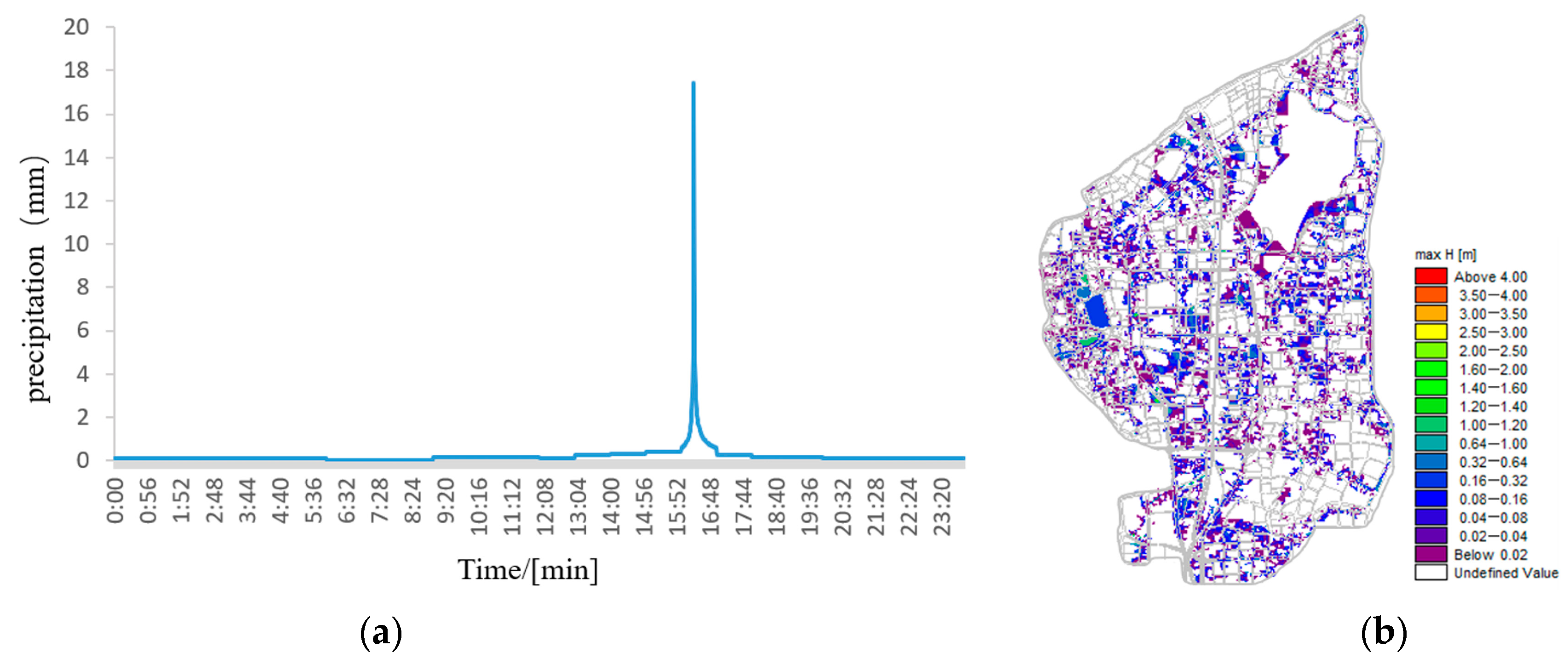
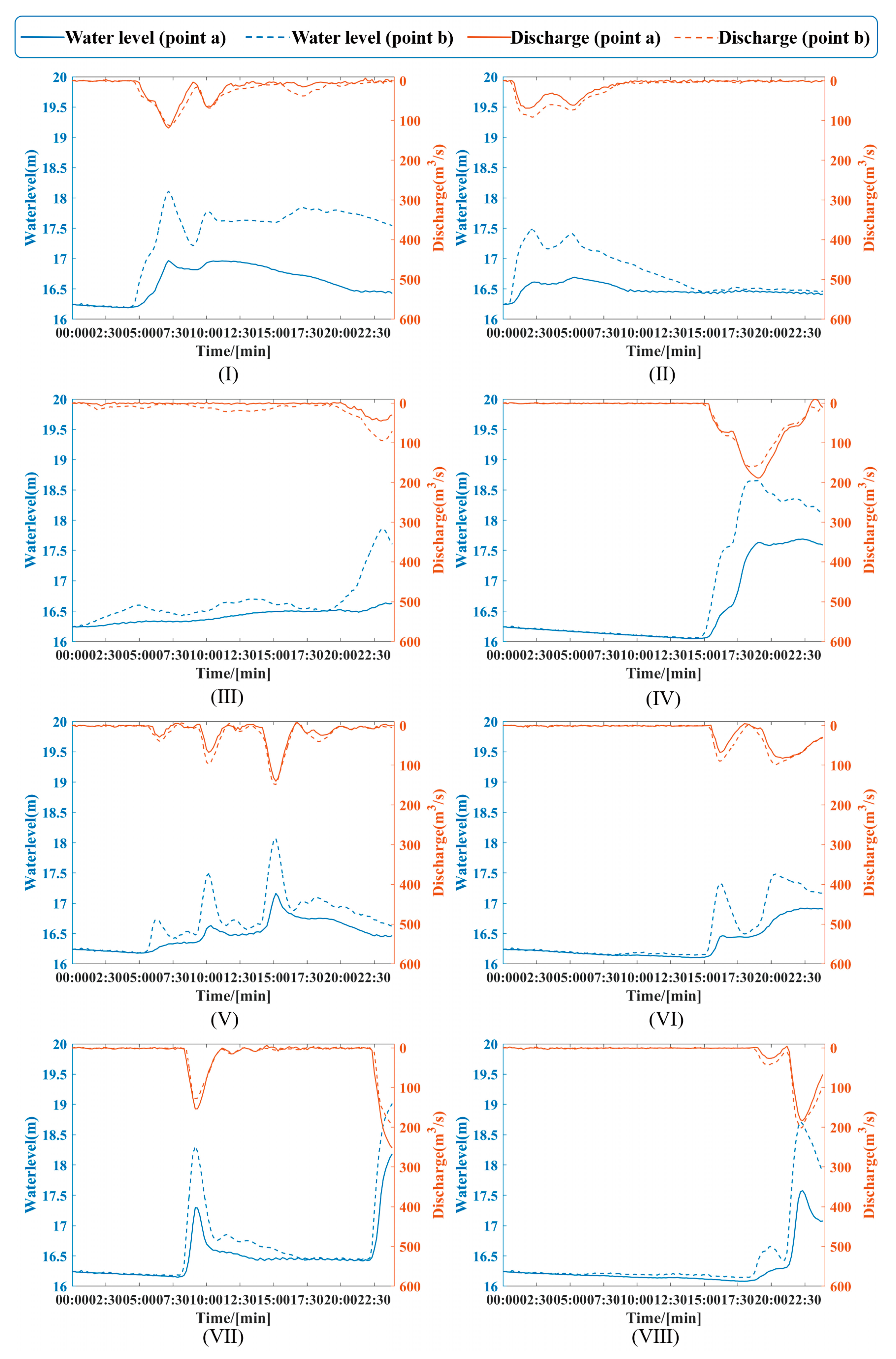
| Precipitation | Monitoring Point | Evaluation Index | Rainfall Patterns | |||||||
|---|---|---|---|---|---|---|---|---|---|---|
| I | II | III | IV | V | VI | VII | VIII | |||
| 233.6 mm | Maximum waterlogged areas (km2) | 0.19 | 0.16 | 0.07 | 0.76 | 1.12 | 0.21 | 2.77 | 4.33 | |
| Maximum waterlogged depth (m) | 1.76 | 1.70 | 1.95 | 2.09 | 2.32 | 1.91 | 2.53 | 3.01 | ||
| a | Max water level (m) | 16.97 | 16.69 | 16.64 | 17.69 | 17.16 | 16.92 | 18.18 | 17.58 | |
| Max discharge (m3/s) | 118.98 | 68.91 | 45.03 | 188.84 | 140.16 | 82.67 | 252.50 | 183.39 | ||
| b | Max water level (m) | 17.39 | 16.95 | 16.79 | 18.13 | 17.71 | 17.18 | 18.70 | 18.14 | |
| Max discharge (m3/s) | 70.95 | 61.02 | 44.89 | 116.75 | 116.61 | 65.18 | 161.34 | 158.44 | ||
| Precipitation | Evaluation Index | Rainfall Patterns | |||||||
|---|---|---|---|---|---|---|---|---|---|
| I | II | III | IV | V | VI | VII | VIII | ||
| 287.4 mm | Maximum waterlogged areas (km2) | 0.518 | 0.39 | 0.201 | 3.151 | 2.996 | 0.741 | 6.439 | 8.215 |
| Maximum waterlogged depth (m) | 1.888 | 1.789 | 2.144 | 4.13 | 2.665 | 2.15 | 4.67 | 3.194 | |
| Precipitation | Monitoring Point | Evaluation Index | Rainfall Patterns | |||||||
|---|---|---|---|---|---|---|---|---|---|---|
| I | II | III | IV | V | VI | VII | VIII | |||
| 287.4 mm | a | Max water level (m) | 17.79 | 17.09 | 17.413 | 18.309 | 17.523 | 17.144 | 18.479 | 18.142 |
| Max discharge (m3/s) | 185.538 | 120.886 | 157.103 | 248.522 | 177.49 | 115.412 | 288.899 | 247.549 | ||
| b | Max water level (m) | 18.11 | 17.486 | 17.862 | 18.654 | 18.071 | 17.483 | 19.014 | 18.714 | |
| Max discharge (m3/s) | 113.639 | 91.558 | 94.76 | 160.345 | 148.81 | 99.22 | 195.336 | 202.675 | ||
Disclaimer/Publisher’s Note: The statements, opinions and data contained in all publications are solely those of the individual author(s) and contributor(s) and not of MDPI and/or the editor(s). MDPI and/or the editor(s) disclaim responsibility for any injury to people or property resulting from any ideas, methods, instructions or products referred to in the content. |
© 2023 by the authors. Licensee MDPI, Basel, Switzerland. This article is an open access article distributed under the terms and conditions of the Creative Commons Attribution (CC BY) license (https://creativecommons.org/licenses/by/4.0/).
Share and Cite
Wu, Y.; Tang, M.; Zhou, Z.; Chu, J.; Zeng, Y.; Zhan, M.; Xu, W. Rainfall Pattern Construction Method Based on DTW-HCA and Urban Flood Simulation: A Case Study of Nanchang City, China. Water 2024, 16, 65. https://doi.org/10.3390/w16010065
Wu Y, Tang M, Zhou Z, Chu J, Zeng Y, Zhan M, Xu W. Rainfall Pattern Construction Method Based on DTW-HCA and Urban Flood Simulation: A Case Study of Nanchang City, China. Water. 2024; 16(1):65. https://doi.org/10.3390/w16010065
Chicago/Turabian StyleWu, Yuze, Ming Tang, Zuhao Zhou, Junying Chu, Yanlin Zeng, Mingjin Zhan, and Wenbin Xu. 2024. "Rainfall Pattern Construction Method Based on DTW-HCA and Urban Flood Simulation: A Case Study of Nanchang City, China" Water 16, no. 1: 65. https://doi.org/10.3390/w16010065
APA StyleWu, Y., Tang, M., Zhou, Z., Chu, J., Zeng, Y., Zhan, M., & Xu, W. (2024). Rainfall Pattern Construction Method Based on DTW-HCA and Urban Flood Simulation: A Case Study of Nanchang City, China. Water, 16(1), 65. https://doi.org/10.3390/w16010065






